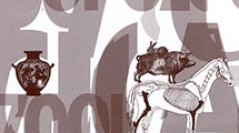

 Anthropozoologica
44 (2) - Pages 7-34
Anthropozoologica
44 (2) - Pages 7-34This paper is aimed at verifying the significance of the zoomorphic images represented in the 12th century picture of the Genoard, the "earthly paradise", of Palermo (Sicily) contained in an illumination in the Liber ad honorem Augusti by Pietro da Eboli, 12th century A.D. (Berne, Burgerbibliothek, Codex 120). Based on analyses of the literary and iconographic documents and of the available osteological evidence, a tentative identification of the zoological species represented is made, in relation to the Norman cultural ambit and what can be assumed about their occurrence in mediaeval Sicily. The study of the animals depicted could enhance our understanding of the specialised - but still debated - use of the Genoard, while also yielding different readings from those traditionally offered by literary and architectural criticism and/or historical and artistic texts. Hence, it offers an opportunity for meditation on the faunistic rebalancing which was implemented also in other continental and insular areas of the northern Mediterranean in the period of Arab influence and/or those immediately following. Perhaps, with certain consequences that could apparently also have involved the contemporary Norman cultural world of Great Britain.
Medieval Sicily, Norman Palermo, Islamic culture, exotic mammals, birds and reptiles, Islamic Spain and Portugal, Crete, Norman England, earthly paradise, viridarium.